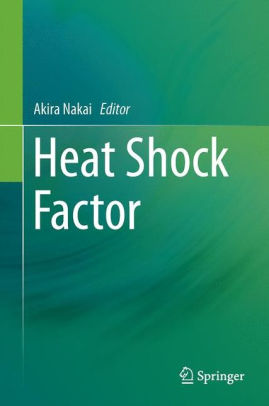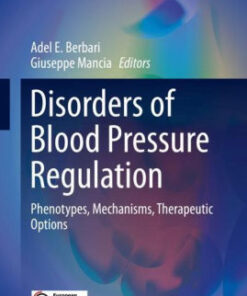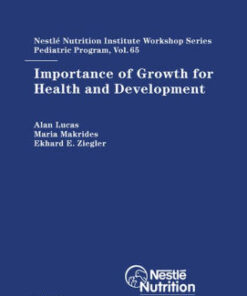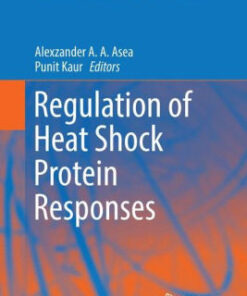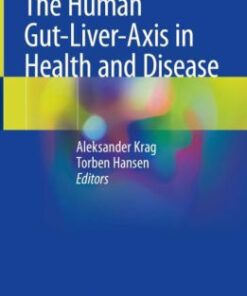(PDF) Heat Shock Factor by Akira Nakai
$18.00
Download instantly Heat Shock Factor by Akira Nakai. It is ebook in PDF format.
ISBN-10: 4431558500 ISBN-13: 9784431558507
Preview
This is the PDF eBook version for Heat Shock Factor by Akira Nakai
Table of Contents
Preface
Contents
Part I: The Basis of HSF Biology
Chapter 1: Proteostasis and Adaptation to High Temperature Stress
1.1 Introduction
1.2 Discovery of the Heat Shock Response
1.3 Heat Shock Proteins as Molecular Chaperones
1.4 Protein Folding
1.5 Proteotoxic Stress Responses Maintain the Balance of Quality and Quantity of the Proteins
1.6 Heat Shock-Specific Transcription Factors
1.7 HSF Is Essential for Normal Growth in Yeast
1.8 HSFs Are Dispensable for Normal Growth in Metazoan Species
1.9 Vertebrate HSFs Play Roles in Adaptation to High Temperature
1.10 The Heat Shock Response in Organisms Living at Various Temperatures
1.11 Conclusions and Perspectives
References
Chapter 2: Structure and Function of the HSF Family Members
2.1 Introduction
2.2 Structure of the HSF Family Members
2.2.1 DNA-Binding Domain
2.2.2 Oligomerization Domain
2.2.3 Nuclear Localization Signal
2.2.4 Transcriptional Activation Domain
2.3 Vertebrate HSF Gene Family
2.4 Potential to Activate HSP and Non-HSP Genes During Heat Shock
2.5 Oligomeric State
2.6 Recognition Sequences
2.7 Cooperativity and Competition Between Distinct HSFs
2.8 Future Perspectives
References
Chapter 3: Regulation of HSF Activation and Repression
3.1 Introduction
3.2 Trimer Formation and the Acquisition of Transcriptional Activity
3.3 Release from Feedback Repression by HSPs
3.4 HSF Directly Senses Heat and Stimuli
3.5 Posttranslational Modifications
3.5.1 Phosphorylation
3.5.2 Sumoylation
3.5.3 Acetylation
3.5.4 Thiol Oxidation
3.6 Other Regulations
3.7 HSF Activation by Diverse Stresses
3.7.1 Environmental Stimuli
3.7.2 Physiological Stimuli
3.7.3 Pathological Stimuli
3.7.4 Small Compounds
3.8 Future Perspectives
References
Chapter 4: Transcriptional Regulation by HSF
4.1 Introduction
4.2 Inducible Gene Expression in General
4.3 Regulation of Constitutive Gene Expression by HSF1
4.3.1 HSP70 Gene in Drosophila
4.3.2 HSP70 Gene in Mammals
4.4 Regulation of Heat Shock-Induced Gene Expression by HSF
4.4.1 HSP70 Gene in Drosophila
4.4.2 HSP70 Gene in Mammals
4.5 Shutdown of HSF Activity
4.6 Suppression of Gene Expression by HSF
4.7 Genes Regulated by HSF
4.7.1 HSF1
4.7.2 HSF2
4.7.3 HSF4
4.8 Future Perspectives
References
Part II: Physiological Roles of HSF
Chapter 5: HSF1 Regulation in Aging and Its Role in Longevity
5.1 Introduction
5.2 The Loss of Proteostasis Is a Hallmark of Aging
5.2.1 When Does Proteostasis Collapse?
5.2.2 Age-Dependent Changes in HSR Activation
5.2.3 Age-Dependent Changes in Proteostatic Network Composition
5.2.4 Age-Dependent Changes in Protein Folding and Aggregation
5.2.5 Modulating HSF1 Levels Can Affect Proteostatic Collapse
5.3 HSF1 Is a Lifespan Regulator
5.3.1 HSF1 Is Required for Insulin/IGF-1 Signaling (IIS) Pathway Activity
5.3.2 HSF1 Is Required for Germline Stem Cell (GSC) Signaling
5.3.3 HSF1 Is Required in Part for Dietary Restriction (DR)
5.3.4 HSF1 Is Differentially Regulated in Development and in Adulthood
5.4 Cell-Autonomous and Cell-Nonautonomous Regulation of HSF1
5.4.1 Neuronal Regulation of HSF1
5.4.2 IIS-Mediated Regulation of HSF1
5.4.3 SIRT1-Mediated Regulation of HSF1
5.4.4 Germline Stem Cell-Mediated Regulation of HSF1
5.4.5 Tissue-to-Tissue HS Signaling
5.5 Perspectives
References
Chapter 6: HSF Modulates Neural Development Under Normal and Stress Conditions
6.1 Introduction
6.1.1 Normal Cortical Development and Its Disturbance by Environmental Stress
6.2 Roles of HSFs in Normal Cortical Development
6.2.1 HSF1 Controls Normal Neurogenesis, Gliogenesis, and Behavior
6.2.2 HSF2 Is Required for Proper Neuronal Migration in the Cerebral Cortex
6.3 Roles of HSFs in Cortical Development Under Conditions of Prenatal Exposure to Adverse Condition
6.3.1 HSF1 Protects the Embryonic Cortex from Various Types of Environmental Stress
6.3.2 HSF1-HSF2 Heterotrimer Participates in the Control of Pathological Cortical Development
6.3.3 HSF1 May Control Neurogenesis Through the Control of Synaptic Functions and the GABAergic Syst
6.4 Perspective
References
Chapter 7: HSF Maintains Sensory Organs
7.1 Introduction
7.2 HSF4 Is Required for Maintenance of the Lens
7.2.1 Mutation of HSF4 in Human Hereditary Cataract
7.2.2 Inactivation of HSF4 Causes Cataract in Mice
7.2.3 HSF4 Regulates Differentiation into Fiber Cells
7.2.4 HSF4 Is Associated with Changes in Chromatin Modification
7.3 HSF1 Is Required for Olfactory Neurogenesis
7.3.1 Abnormal Nasal Cavity in HSF1-Null Mice
7.3.2 Maintenance of Olfactory Neurogenesis by HSF1
7.3.3 Maintenance of Ciliary Beating by HSF1
7.4 HSF1 Protects the Sensory Hair Cells from Damage
7.5 Future Perspectives
References
Chapter 8: HSF Is Required for Gametogenesis
8.1 Introduction
8.2 Normal Spermatogenesis
8.2.1 Roles of HSF1 in Normal Spermatogenesis
8.2.2 Roles of HSF2 in Normal Spermatogenesis
8.2.3 Another HSF in Spermatogenesis
8.3 Normal Oogenesis
8.3.1 Roles of HSF1 in Normal Oogenesis
8.3.2 Roles of HSF2 in Normal Oogenesis
8.4 HSF in Stressed Spermatogenesis and Its Clinical Significance
8.4.1 Role of HSFs on Heat-Induced Spermatogenic Cell Death
8.4.2 Cryptorchidism
8.4.3 Varicocele
8.4.4 Genotoxic Stress
8.5 Summary and Future Perspectives
References
Chapter 9: HSF Regulates Immune and Inflammatory Response
9.1 Introduction
9.2 Contribution of Immune System in Inflammatory and Febrile Responses
9.2.1 Inflammatory Response
9.2.2 Febrile Response
9.3 Beneficial Effects of Fever on Pathological Conditions
9.4 HSF Inhibits Expression of the Inflammatory and Pyrogenic Cytokines
9.4.1 Inflammatory Cytokines
9.4.2 Pyrogenic Cytokines
9.4.3 TNF-a
9.4.4 IL-1beta
9.4.5 IL-6
9.4.6 Feedback Regulation of Cytokines by HSF1
9.5 Modulation of T-Cell, B-Cell, and Dendritic Cell Function
9.5.1 T-Cell, B-Cell, and Dendritic Cells
9.5.2 Roles of HSPs in the Immune Cell Function
9.6 Inflammatory Diseases (Arthritis, Inflammatory Bowel Disease, etc.)
9.6.1 Rheumatoid Arthritis
9.6.2 Inflammatory Bowel Disease
9.7 Future Perspectives
References
Chapter 10: Heat Shock Factors Modulate Circadian Rhythms
10.1 Introduction
10.2 Molecular Mechanism of the Circadian Clock in Mammals
10.3 Effect of Temperature on Circadian Clock Function
10.4 Regulation of Circadian Gene Expression by HSF1
10.5 Role of HSF1 in Temperature-Dependent Regulation of the Circadian Clock
10.6 Cross Talk Between HSF and Light Response in the Chick Pineal Gland
10.7 Future Perspectives
References
Part III: Diseases Associated with HSF Function
Chapter 11: HSF Inhibits the Progression of Age-Related Neurodegenerative Diseases
11.1 Introduction
11.2 Features of Neurodegenerative Diseases
11.2.1 Age-Related Neurodegenerative Diseases
Polyglutamine Diseases
Alzheimer´s Disease
Parkinson´s Disease
Amyotrophic Lateral Sclerosis (ALS)
11.2.2 Common Mechanisms of Neurodegenerative Disease
Conformational Changes and Protein Aggregation
Proteostasis Disruption
Transcriptional Dysregulation
Axonal Transport Disruption of Axonal Transport
Synaptic Dysfunction
Mitochondrial Dysfunction
Excitotoxicity
11.3 HSF Suppresses the Progression of Polyglutamine Diseases, Alzheimer´s Disease, and Parkinson´
11.3.1 The Role of the HSF-HSP Pathway in Protein-Misfolding Diseases
11.3.2 HSF Is a Key Player in Protein-Misfolding Diseases and Aging
11.3.3 HSF Suppresses the Progression of Alzheimer´s Disease, Parkinson´s Disease, Polyglutamine D
AD
PD
Polyglutamine Diseases
ALS
11.3.4 Pharmacological Induction of the HSF-HSP Pathway as a Therapeutic Strategy for Neurodegenerat
17-AAG
Celastrol
GGA
Arimoclomol
Paeoniflorin
11.4 Propagation Modulated by the HSF-HSP Pathway
11.5 Future Perspectives
11.5.1 Adequacy of Animal Models
11.5.2 Reproducibility of Preclinical Studies
11.5.3 Dosage, Timing, and Duration of Intervention
11.5.4 Drug Delivery
References
Chapter 12: HSF and Heart Diseases
12.1 Introduction
12.2 Protein Metabolism and Signaling in Heart Cells
12.2.1 HSF1 and HSF2 in the Heart
12.2.2 Control of HSF1 Activation
12.2.3 Regulatory Role of HSF1 in the Heart
12.2.4 Heat Shock Paradox
12.3 Ischemic Heart Disease and HSF
12.3.1 HSF1 and Myocardial Infarction
12.3.2 HSF1 and Cardiac Pathologic Hypertrophy
12.3.3 HSF1 and Atherosclerosis
12.4 Heart Failure and HSF
12.5 Future Perspectives
References
Chapter 13: HSF Supports Cancer
13.1 Introduction
13.2 Biology of HSF1-Associated Cancers
13.2.1 Cancer Cells Are Generally Exposed to Stressful Environments That Promote HSF1 Activity
13.2.2 Oncogene Versus Non-oncogene Addiction
13.2.3 HSF1 Is Implicated in the Hallmarks of Cancer
13.3 HSF Supports Cancer Initiation, Promotion, and Progression
13.3.1 HSF1 Plays a Role in Enabling the Initiation and Maintenance of Cancer
13.3.2 HSF1 Affects Oncogene-Induced Senescence
13.3.3 Progression
13.4 Cancer-Related Pathways Regulated by HSF1
13.4.1 HSF1-Bound Genes Are Involved in Many Facets of Tumorigenesis
13.4.2 Signaling Pathways of Cancer Alter HSF1 Activity
13.4.3 Maintenance of Sustained Proliferative Signaling
13.4.4 Activation of Invasion and Metastasis Pathways
13.4.5 HSF1 Regulates Anabolic Metabolism
13.4.6 HSF1 Plays a Role in Apoptosis Pathways
13.5 HSF and Its Targets as Prognostic Factors in Cancer Patients
13.6 Future Perspectives
References
Chapter 14: HSF1 Activation by Small Chemical Compounds for the Treatment of Neurodegenerative Disea
14.1 Introduction
14.2 HSF1 Activation by Hsp90 Inhibitors
14.3 HSF1 Activation by an Hsp70 Inhibitor
14.4 HSF1 Activation by a TRiC Inhibitor
14.5 Prolongation of HSF1 Activity
14.6 Enhancement of HSF1 Activity
14.7 Inhibition of HSF1 Degradation
14.8 Medicinal Plants
14.9 Dexamethasone
14.10 Inhibition of Histone Deacetylase
14.11 Future Perspectives
References
Index
